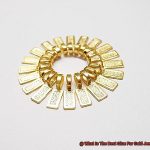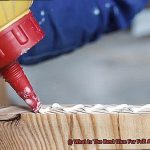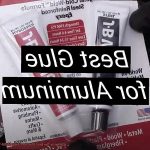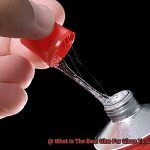Are you tired of struggling to find the perfect horseshoe adhesive? As an equestrian enthusiast, this can be one of the biggest challenges you face. Whether it’s a temporary fix or a permanent solution, there’s a lot to consider when glueing horseshoes. With so many products out there, it’s easy to feel overwhelmed and unsure about which one is the best fit for your horse.
Thankfully, horseshoe glue has come a long way over the years. Traditional methods like nailing into the hoof have given way to modern techniques like glue-on horseshoes. These have become increasingly popular among equestrians due to their comfort and health benefits for horses.
But with so many options on the market, what is the best glue for glue on horseshoes? That’s the million-dollar question. From acrylic-based adhesives to urethane-based adhesives, each product has its own unique set of benefits and drawbacks. Choosing the right one depends on your horse’s needs and your personal preferences.
In this blog post, we’ll explore the most popular types of horseshoe glue and break down their pros and cons. We’ll provide you with all the information you need to make an informed decision about which adhesive is right for you and your equine friend. So sit tight and get ready to learn everything you need to know about finding the best glue for glue on horseshoes.
Different Types of Glue Used for Glue On Horseshoes
Contents
When it comes to glueing on horseshoes, there are several types of adhesives available that vary in composition, strength, and application process. Let’s explore the different types of glue used for glueing on horseshoes in detail.
Acrylic adhesives are a popular choice for glueing on horseshoes due to their strength and durability. They form a strong bond with metal and other surfaces and are resistant to water, chemicals, and heat. Acrylic adhesives can be easily applied using a dispensing gun or syringe. They are ideal for horses that frequently encounter wet conditions but may not be the best choice for high-impact activities.
Polyurethane adhesives also offer excellent bonding capability and work well on porous surfaces. They can withstand high levels of stress and strain and are easy to apply using a dispensing gun or syringe. Polyurethane adhesives are a good choice for horses that engage in high-impact activities like jumping or racing.
Epoxy adhesives are known for their incredible strength and ability to bond well with metals and other materials. They can even be used to fill gaps between two surfaces. However, epoxy adhesives take longer to cure than other types of glue, which may not be suitable for some users who need quick results.
Cyanoacrylate adhesives, commonly known as superglue, are quick-drying and easy to apply. They form a strong bond with the hoof wall but may not be as durable as other adhesives. Cyanoacrylate adhesive is a good option for small repairs or attaching small items to horseshoes.
Silicone adhesives are known for their flexibility and resistance to water and extreme temperatures. They can be used to attach horseshoes in wet or damp conditions and absorb shock, making them ideal for horses that engage in high-impact activities. However, silicone adhesive may not be as strong as other types of glue and may not be suitable for all horses or shoe types.
Choosing the best glue for glueing on horseshoes requires considering several factors such as the type of surface you are bonding, the level of stress the bond will be subjected to, and the environmental conditions where the bond will be exposed. Each type of adhesive has its own strengths and weaknesses, and a skilled farrier will be able to assess these factors and choose the best adhesive for each individual horse.
In conclusion, selecting the right type of glue for glueing on horseshoes is essential for the health and well-being of your horse. It is crucial to consider the horse’s needs, shoe type, and environmental conditions when choosing an adhesive.
Advantages of Polyurethane Adhesive
Among the many options available, polyurethane adhesive stands out for its exceptional properties that make it an ideal choice for bonding horseshoes to hooves.
One of the most significant advantages of polyurethane adhesive is its strength and durability. Horses are constantly on the move and under pressure, so it’s crucial to use a glue that can withstand the wear and tear caused by their movement. Polyurethane adhesive creates a strong and reliable bond between the horseshoe and the hoof, ensuring that your equine companion stays comfortable and safe.

In addition to its exceptional strength, polyurethane adhesive is waterproof and weather-resistant. This means that it won’t break down or weaken in wet or humid conditions, making it an excellent option for horses that frequently encounter wet or muddy terrain. Moreover, polyurethane adhesive can withstand extreme temperatures, guaranteeing that the bond between the horseshoe and the hoof remains secure in any weather condition.
Polyurethane adhesive also has a fast curing time, setting quickly once applied. This feature is particularly beneficial because horses can become uneasy during shoeing. With a fast-curing adhesive like polyurethane, you can minimize discomfort for your horse during the shoeing process.
In summary, polyurethane adhesive is an outstanding option for horse owners and farriers seeking a reliable, durable glue for horseshoeing. Here are some key advantages to keep in mind:
- High-strength bonding properties for maximum durability
- Waterproof and weather-resistant for all conditions
- Fast curing time to minimize discomfort for your horse
Advantages of Acrylic Adhesive
Acrylic adhesive is a game-changer when it comes to glueing horseshoes. As an expert in horse care, I know that this type of thermoplastic adhesive offers many advantages that make it stand out from other adhesives in the market. Let’s take a closer look at some of these advantages.
First and foremost, acrylic adhesive is known for its high strength and durability. It can withstand even the harshest weather conditions, including extreme temperatures and moisture, without losing its bonding strength. This makes it the perfect choice for horses that are frequently exposed to outdoor environments.
Another great feature of acrylic adhesive is its fast-setting time. It dries quickly, allowing horses to resume their activities without any delay. What’s more, it forms a strong bond with the horseshoe, preventing it from slipping or falling off during rigorous activity.
Acrylic adhesive is also incredibly easy to work with. It comes in various forms such as cartridges, syringes, and bottles, providing users with convenience and flexibility when choosing the best option for their needs. And if you make any mistakes during application, don’t worry. Acrylic adhesive can be easily removed and cleaned up with solvents like acetone or alcohol.
Lastly, safety is always a top priority when working with animals. Acrylic adhesive is non-toxic and free from harmful chemicals like formaldehyde or toluene that can cause health problems. It also doesn’t emit any harmful fumes or odors that could irritate your horse’s respiratory system, making it safe for both humans and animals.
Advantages of Epoxy Adhesive
First and foremost, epoxy adhesive boasts an impressive bonding power. Unlike mechanical fasteners such as nails or screws, it creates a chemical bond that is incredibly strong. This is particularly crucial for horseshoes since they are subjected to significant stress and impact during activities like running and jumping. With epoxy adhesive, you can rest easy knowing your horse’s superhero shoes will stay in place no matter what.
But wait, there’s more. Epoxy adhesive also has the unique ability to fill gaps and voids between the horseshoe and the hoof. This tight fit ensures that debris and moisture cannot get trapped, which could lead to infections or other hoof-related problems. This feature alone makes it a game-changer for horse owners looking to ensure their horses’ overall health and well-being.
Another advantage of epoxy adhesive is its resistance to temperature fluctuations, moisture, and chemicals. Horses are often exposed to wet or muddy conditions, which can weaken the bond between the horseshoe and the hoof. Epoxy adhesive can withstand exposure to moisture without losing its strength or bonding properties. This means that your horse’s horseshoes will stay securely in place for longer periods without needing to be re-glued.
Lastly, epoxy adhesive is incredibly easy to apply. It can be mixed and applied with a syringe or spatula, making it a convenient option for farriers during shoeing appointments. This feature makes it a time-saving solution that can benefit both the farrier and the horse owner.
Factors to Consider When Choosing the Best Glue
To achieve this, there are several critical factors that you must consider when choosing the best glue for glue on horseshoes.
Firstly, adhesion strength is paramount. You need a glue that can handle the stresses of jumping or racing without compromising the bond between the horseshoe and hoof. The adhesive strength should be strong enough to withstand these rigorous activities.
Secondly, drying time is another critical factor. You need a quick-drying glue to avoid making your horse stand for an extended period, waiting for the glue to dry. A fast-drying glue is more convenient and saves time.
Thirdly, flexibility is essential. Horses’ hooves tend to expand and contract with changes in temperature and moisture levels; therefore, you need a flexible glue that can handle these changes without losing its adhesive properties. A flexible adhesive will maintain the bond between the horseshoe and hoof even during varying weather conditions.
Fourthly, non-toxicity is crucial. Toxic glues can cause severe health issues for horses, including infections or respiratory problems. It is essential to choose a non-toxic option to ensure your horse’s safety.
Lastly, ease of application is vital. Gluing horseshoes can be challenging, even for experienced farriers, so you want a glue that is easy to apply, even if you lack experience. An easy-to-apply adhesive will make the gluing process more efficient and less stressful.
Tips for Applying Glue to Horseshoes

The use of glue has become increasingly popular in recent years, but it’s essential to apply the glue correctly to ensure a strong and long-lasting bond. Here are some tips to help you achieve the perfect horseshoe application:
Choose the Right Glue
Choosing the right glue is crucial for a successful bond between the shoe and the hoof. Consider your horse’s activity level and lifestyle when selecting the glue. For example, if your horse is highly active, epoxy may be the best option for its durability.
Prepare the Surface
Properly cleaning and preparing the surface of both the hoof and shoe is vital to ensure maximum adhesion. The surfaces should be free from any dirt, debris, or old adhesive.
Apply Evenly
When applying the glue, it’s important to use a consistent amount and spread it evenly across the surface of the horseshoe. You may want to use a brush or spreader tool to achieve an even application.
Use Clamps or Tools
To ensure a secure and even bond, consider using clamps or other tools to hold the shoe in place while the glue sets. This will also help prevent any movement that could compromise the bond.
Allow Time to Dry
Allowing sufficient time for the glue to fully cure before putting any weight or stress on the shoe is essential. Following the manufacturer’s instructions for curing time is recommended for best results.
How to Remove Glue from Horseshoes
When it comes to removing glue from horseshoes, it’s important to take a careful and cautious approach. Here are five key steps to help you safely remove glue from your horse’s shoes:
Clean the hoof
Start by thoroughly cleaning the hoof to ensure there is no dirt or debris around the shoe. Use a hoof pick to remove any buildup, then brush the area with water and dry it completely before proceeding.
Remove excess glue
Use a scraper or metal tool to gently remove any excess glue from the shoe. Be careful not to damage the shoe or the hoof while doing this, as both are delicate and require careful handling.
Choose a solvent
Acetone is a popular solvent for removing glue from horseshoes, but be sure to read the product label carefully and follow all safety instructions. Apply a small amount of acetone to a cloth or cotton ball and rub it over the remaining glue, allowing it to soak in for a few minutes before using a scraper or metal tool to gently remove the softened glue.
Consider commercial adhesive remover
If acetone doesn’t work, consider using a commercial adhesive remover specifically designed for removing glue from horseshoes. These products can be found at most equine supply stores and are typically easy to use.
Be patient
Removing glue from horseshoes can be a time-consuming process that requires patience and care. Avoid using excessive force or harsh chemicals that could damage the hoof or shoe. If you’re unsure about how to proceed, it’s always best to seek guidance from a professional farrier who can provide expert advice and assistance.
Conclusion
In conclusion, selecting the best glue for horseshoes can be a daunting task, given the plethora of options available in the market. However, it’s crucial to consider several factors when choosing an adhesive that works best for your horse. The surface you are bonding, the level of stress the bond will undergo, and the environmental conditions where the bond will be exposed are all critical considerations.
There are various popular choices for glueing on horseshoes, including acrylic-based adhesives, polyurethane-based adhesives, epoxy adhesives, cyanoacrylate adhesives (superglue), and silicone adhesives. Each product has its unique set of benefits and drawbacks. Therefore, selecting the right one depends on your horse’s needs and your personal preferences.
Polyurethane adhesive is known for its exceptional strength and durability, making it an ideal choice for bonding horseshoes to hooves. Acrylic adhesive is easy to work with and non-toxic. On the other hand, epoxy adhesive boasts incredible bonding power and resistance to temperature fluctuations, moisture, and chemicals.
When applying glue to horseshoes, it’s crucial to choose the right glue type and prepare the surface appropriately. Applying evenly with a consistent amount spread across the horseshoe’s surface using clamps or other tools if necessary is also essential. It’s equally important to allow sufficient time for curing before putting any weight or stress on it.
Removing excess glue from horseshoes requires patience and care not to damage either hoof or shoe while using a scraper or metal tool gently. You can use acetone or commercial adhesive remover if necessary but seeking guidance from a professional farrier is always recommended if unsure about how to proceed.
In summary, finding the best glue for glue on horseshoes may seem overwhelming at first glance but taking into account key considerations such as strength, durability, ease of application and removal will help you make an informed decision.






